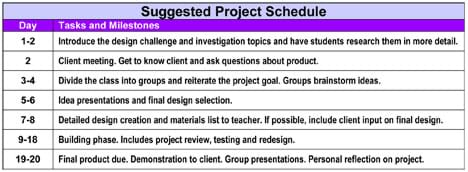
Summary
This unit describes a general approach to guiding students to complete service-based engineering design projects, with specific examples provided in detail as associated activities. With your class, brainstorm ideas for engineering designs that benefit your community or a specific person in your community. Then, guided by the steps of the engineering design process, have students research to understand background science and math, meet their client to understand the problem, and create, test and improve prototype devices. Note that service-based projects often take more time to prepare, especially if you arrange for a real client. However, the authors notice that students of both genders and all ethnicities tend to respond with more enthusiasm and interest to altruistic projects.Engineering Connection
The real world is teeming with opportunities for people, including engineers, to apply their expertise to helping others and improving our general and specific quality of life. This is the very nature of engineering. The work of engineers directly impacts the lives of people in their communities (shelters, playgrounds, water treatment plants, heating and cooling devices, bridges, medical devices, etc.). The associated activity examples engage students in designing prototype devices to help the authors' local community members, but the same approach applies more broadly to teams following the steps of the engineering design process as they come up with solutions to service-based engineering challenges that benefit specific people in their communities and/or society at large.
Unit Overview
This project works well as a semester-long project in a high school engineering class or elective course. Arrange for a real-world client, or create a hypothetical service-based opportunity (perhaps using one of the associated activities). Then, have students follow the steps of the engineering design process while they attempt to solve the open-ended problem, with the main objective to build working prototypes.
For further suggestions and support materials, refer to the Tips for Leading Service-Based Engineering Design Projects and other attachments.
Educational Standards
Each TeachEngineering lesson or activity is correlated to one or more K-12 science,
technology, engineering or math (STEM) educational standards.
All 100,000+ K-12 STEM standards covered in TeachEngineering are collected, maintained and packaged by the Achievement Standards Network (ASN),
a project of D2L (www.achievementstandards.org).
In the ASN, standards are hierarchically structured: first by source; e.g., by state; within source by type; e.g., science or mathematics;
within type by subtype, then by grade, etc.
Each TeachEngineering lesson or activity is correlated to one or more K-12 science, technology, engineering or math (STEM) educational standards.
All 100,000+ K-12 STEM standards covered in TeachEngineering are collected, maintained and packaged by the Achievement Standards Network (ASN), a project of D2L (www.achievementstandards.org).
In the ASN, standards are hierarchically structured: first by source; e.g., by state; within source by type; e.g., science or mathematics; within type by subtype, then by grade, etc.
See individual lessons and activities for standards alignment.
Subscribe
Get the inside scoop on all things TeachEngineering such as new site features, curriculum updates, video releases, and more by signing up for our newsletter!Unit Schedule
See a suggested schedule in Figure 1, based on about twenty 50-minute periods.

Worksheets and Attachments
Visit [www.teachengineering.org/curricularunits/view/cub_service_unit] to print or download.More Curriculum Like This

In this service-learning engineering project, students follow the steps of the engineering design process to design an assistive eating device for a client. More specifically, they design a prototype device to help a young girl who has a medical condition that restricts the motion of her joints to e...
Assessment
Pre/Post Quiz: Personalize the concept inventory, Example Pre/Post Quiz Answers, with topics pertinent to your class' service-based engineering project. Make a blank quiz version without the answers. Before beginning the project, have students complete the quiz. At project completion, have students take the same quiz, comparing their results to their pre-project scores to gauge their knowledge gains.
Other Related Information
Optional: Show students the What Is Engineering? video.
See specifics about implementing the steps of the engineering design process as described in TeachEngineering's Creative Engineering Design unit.
Learn more about the steps of the engineering design process at the Engineering is Elementary website: http://www.mos.org/eie/engineering_design.php
Learn more about the engineering design process at https://www.teachengineering.org/engrdesignprocess.php
For inspiration, see Engineers Without Borders
Copyright
© 2010 by Regents of the University of ColoradoContributors
Eszter Horanyi; Alison Pienciak; Malinda Schaefer Zarske; Denise W. CarlsonSupporting Program
Integrated Teaching and Learning Program, College of Engineering and Applied Science, University of Colorado BoulderAcknowledgements
This digital library content was developed by the Integrated Teaching and Learning Program under National Science Foundation GK-12 grant no. 0338326. However, these contents do not necessarily represent the policies of the National Science Foundation, and you should not assume endorsement by the federal government.
Last modified: February 25, 2020




User Comments & Tips